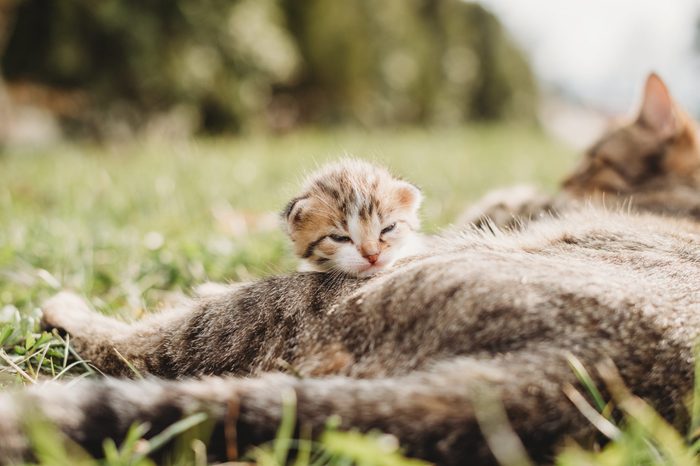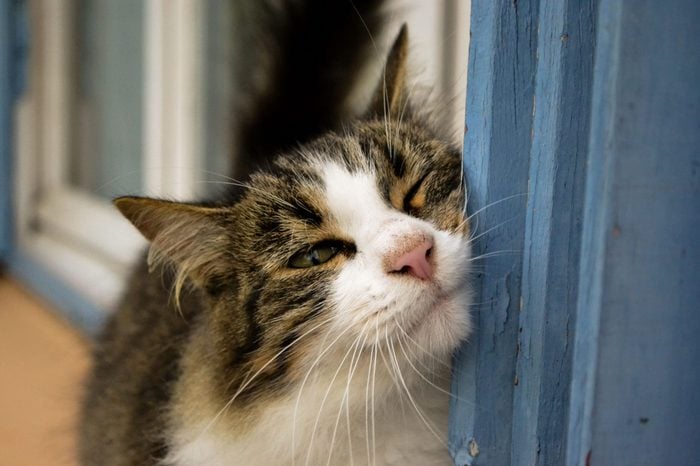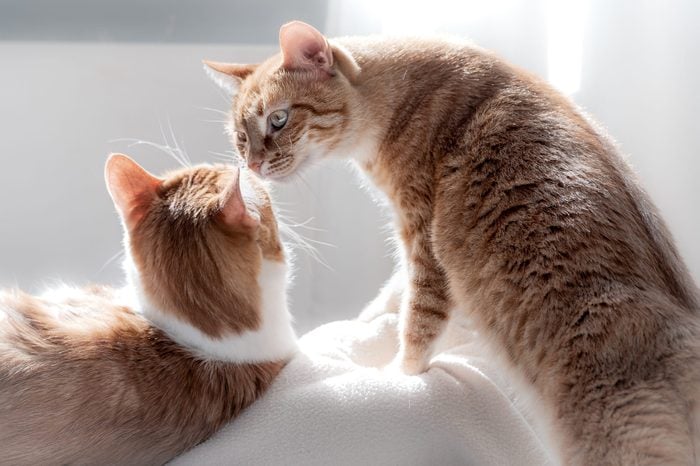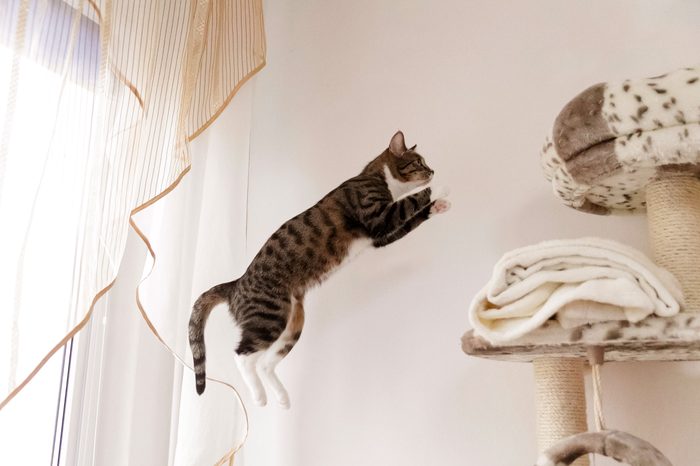
Calling all cat people!
So, you think you’re a cat person? We’ll be the judge of that! Put your kitty knowledge to the test with these 13 questions that will make you appreciate and understand your own favorite feline even more. And when you’re done, check out these other 21 cat facts that are purr-fectly fascinating.

What is a group of kittens called?
You know that a group of birds is a flock and a group of bees is called a swarm. But did you know that a group of kittens is called a kindle? Once they reach adulthood, however, a group of cats is called a clowder, notes the Alpine Animal Hospital. And just for good measure, you should know that a female cat is called a queen and a male cat is called a tom! Check out these other hilarious (but totally real) names for groups of animals.

At what age is a cat no longer considered a kitten?
Cats are technically considered kittens until they turn one year old, according to The Nest. It’s at this point when they reach a final plateau in growth and when their kitten-like tendencies really mellow out. They technically reach sexual maturity around six months to a year (which is when reproductive instincts and abilities kick in), and all their adult teeth are usually in by seven months. Don’t miss these 17 things your cat would love to tell you.

True or false: Cats are more popular pets than dogs
True! While there are roughly 94.2 million household cats in the United States, there are only about 89.7 million dogs, according to Statista. But the number one pet in the country? Freshwater fish, of which 139.3 million swam into the homes (and hearts) of pet owners in 2017 and 2018. For a real treat, check out these kitten pictures of some of the most popular (and arguably the cutest) cat breeds.

What is the average length of a cat pregnancy?
Unlike humans, who carry their babies for nine whole months, cats are pregnant for only about two months, per Fetch by WebMD. Even crazier, you might not even realize that you’re about to become a kitty grandparent. Signs of a cat pregnancy include increased appetite, enlarged or darkened nipples around two weeks in, morning sickness, and a swollen belly. It’s still pretty tricky to decipher whether a cat is pregnant or not without an ultrasound, but if your cat is exhibiting these signs, pay a visit to your vet.

Do cats have more or fewer bones than humans?
If you guessed fewer, you’re incorrect! Though it’s counterintuitive given their small size, cats actually have more bones than humans. While humans have 206 bones in their body, cats have between 230 and 250, depending on the cat. The average cat typically has 244, according to Family Pet. Here are another 60 fun facts about animals you probably didn’t know before.

True or false: A cat has been to outer space
This is surprisingly true, reports Space.com. A French feline by the name of Felicette went to space on October 18th, 1963. Her 15-minute ride nearly 100 miles above Earth exposed her to 9.5 Gs of force, and she was weightless for a short amount of time. This cat is the first and only cat to go to space, and she appropriately earned the nickname “Astrocat.” Did you know that some heroic cats have even served in the military?

What is the average life span of an indoor, domesticated cat?
Indoor cats have an average life span of 12 to 18 years, though many cats can live into their 20s. The oldest cat (that we know of) was 38, reports VetWest Animal Hospitals. Regarding their development, Purina says that the first year of a cat’s life is equivalent to about 15 years of a human’s life, at age two they are on par with a 25-year-old human, and every year after that is roughly equal to seven human years. Make sure you know these 9 trusted tips to help your pet live longer.

How fast can a domesticated cat run?
Believe it or not, domesticated cats can reach speeds of 30 miles per hour, says Purina UK. This may sound surprising, but it makes sense when you think about how quickly they race from one end of the house to the other. For comparison, a cheetah can get up to around 76 miles per hour. Check out these amazing photos of these big, beautiful cats in the wild.

What are the three primary ways cats mark their scent?
You probably know the most obvious way a cat spreads its scent—that’d be through urine marking or spraying—but that’s not the only way they do so. Cats also mark their scent by cheek-rubbing via scent glands on the face and by clawing/scratching via scent glands on their paws, explains Cat Behavior Associates. Regarding the latter, you can keep your cat from scratching the furniture by following this helpful advice.

True or false: Cats are nocturnal creatures
False! Though it’s a commonly perpetuated myth, cats are not nocturnal creatures. Instead, they’re what is referred to as crepuscular, explains Hill’s Pet, which means that they’re most active during dawn and dusk. These are optimal hunting hours, and the sleeping habits are left over from their ancestors. You may notice your cat gets the zoomies around this time—or that it’s eager to wake you up at the crack of dawn for breakfast! By the way, this is the very best diet for cats, according to vets.

Where are a cat’s whiskers located?
If you thought this was a trick question, you are correct! Though cats are known for the long whiskers on their cheeks, they also have whiskers on their eyes, ears, and forelegs, says Mother Nature Network. Whiskers have “proprioceptors” built into them, which help felines assess the space around them. Here are some more common “facts” about cats that are actually false.

True or false: Cats communicate with fellow cats via meowing
This is false. Cats do not use meowing as a way to communicate with other cats—that’s a special behavior reserved for their humans! According to research reported on by the New Yorker, the cat meow was developed as a way for cats to communicate with their human owners, and each cat actually has a unique vocalization vocabulary to help them get what they need, whether that’s snuggles or food. And the reasons cats purr may also be different than you think.

How many feet can a cat jump on average? Three, four, or five?
If you’ve witnessed your own feline make it to the top of the fridge, you probably guessed the correct answer, which is five feet, says PetFinder. And that’s a vertical jump—without running. As they get older, their ability to jump as high diminishes, but in their youth, they can very easily access tall spaces. Next, find out the telltale signs your cat is happy.
